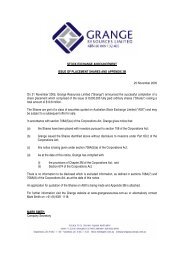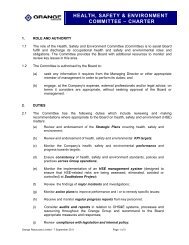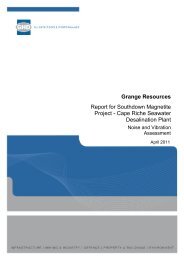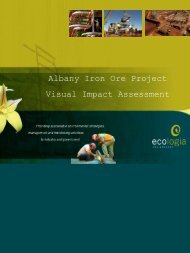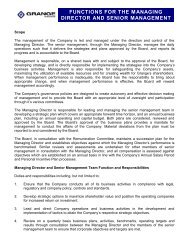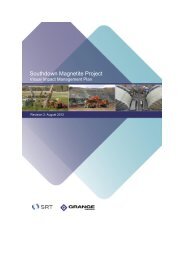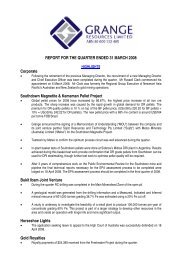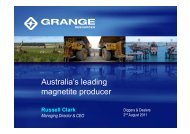2012 Annual Report (2 April 2013) - Grange Resources
2012 Annual Report (2 April 2013) - Grange Resources
2012 Annual Report (2 April 2013) - Grange Resources
You also want an ePaper? Increase the reach of your titles
YUMPU automatically turns print PDFs into web optimized ePapers that Google loves.
<strong>2012</strong> ANNUAL REPORT<br />
59<br />
PAGE<br />
AASB 10 replaces all of the guidance on control and<br />
consolidation in AASB 127 Consolidated and Separate<br />
Financial Statements, and Interpretation 12 Consolidation<br />
– Special Purpose Entities. The core principle that a<br />
consolidated entity presents a parent and its subsidiaries as<br />
if they are a single economic entity remains unchanged, as<br />
do the mechanics of consolidation. However the standard<br />
introduces a single definition of control that applies to all<br />
entities. It focuses on the need to have both power and<br />
rights or exposure to variable returns before control is<br />
present. Power is the current ability to direct the activities<br />
that significantly influence returns. Returns must vary and<br />
can be positive, negative or both. There is also new guidance<br />
on participating and protective rights and on agent/principal<br />
relationships.<br />
AASB 11 introduces a principles based approach to<br />
accounting for joint arrangements. The focus is no longer<br />
on the legal structure of joint arrangements, but rather on<br />
how rights and obligations are shared by the parties to the<br />
joint arrangement. Based on the assessment of rights and<br />
obligations, a joint arrangement will be classified as either a<br />
joint operation or joint venture. Joint ventures are accounted<br />
for using the equity method, and the choice to proportionately<br />
consolidate will no longer be permitted. Parties to a joint<br />
operation will account their share of revenues, expenses,<br />
assets and liabilities in much the same way as under the<br />
previous standard. AASB 11 also provides guidance for<br />
parties that participate in joint arrangements but do not share<br />
joint control. AASB 12 sets out the required disclosures for<br />
entities reporting under the two new standards, AASB 10 and<br />
AASB 11, and replaces the disclosure requirements currently<br />
found in AASB 128. Application of this standard by the Group<br />
will not affect any of the amounts recognised in the financial<br />
statements, but will impact the type of information disclosed<br />
in relation to the Group’s investments.<br />
Amendments to AASB 128 provide clarification that an<br />
entity continues to apply the equity method and does not<br />
remeasure its retained interest as part of ownership changes<br />
where a joint venture becomes an associate, and vice versa.<br />
The amendments also introduce a “partial disposal” concept.<br />
The Group is still assessing the impact of these amendments.<br />
The Group does not expect to adopt the new standards<br />
before their operative date. They would therefore be first<br />
applied from 1 January <strong>2013</strong>.<br />
(iii) AASB 13 Fair Value Measurement and AASB 2011-<br />
8 Amendments to Australian Accounting Standards<br />
arising from AASB 13 (effective 1 January <strong>2013</strong>)<br />
AASB 13 was released in September 2011. It explains how to<br />
measure fair value and aims to enhance fair value disclosures.<br />
The Group has yet to determine which, if any, of its current<br />
measurement techniques will have to change as a result<br />
of the new guidance. It is therefore not possible to state<br />
the impact, if any, of the new rules on any of the amounts<br />
recognised in the financial statements. However, application of<br />
the new standard will impact the type of information disclosed<br />
in the notes to the financial statements. The Group does not<br />
intend to adopt the new standard before its operative date,<br />
which means that it would be first applied from 1 January<br />
<strong>2013</strong>.<br />
(iv) AASB 2011-9 Amendments to Australian Accounting<br />
Standards – Presentation of Items of Other<br />
Comprehensive Income (effective 1 July <strong>2012</strong>)<br />
In September 2011, the AASB made an amendment to AASB<br />
101 Presentation of Financial Statements which requires<br />
entities to separate items presented in other comprehensive<br />
income into two groups, based on whether they may be<br />
recycled to profit or loss in the future. This will not affect the<br />
measurement of any of the items recognised in the balance<br />
sheet or the profit or loss in the current period. The Group<br />
intends to adopt the new standard from 1 January <strong>2013</strong>.<br />
(v) AASB 2011-4 Amendments to Australian Accounting<br />
Standards to Remove Individual Key Management<br />
Personnel Disclosure Requirements (effective 1 July <strong>2013</strong>)<br />
In July 2011 the AASB decided to remove the individual key<br />
management personnel (KMP) disclosure requirements from<br />
AASB 124 Related Party Disclosures, to achieve consistency<br />
with the international equivalent standard and remove<br />
a duplication of the requirements with the Corporations<br />
Act 2001. While this will reduce the disclosures that are<br />
currently required in the notes to the financial statements, it<br />
will not affect any of the amounts recognised in the financial<br />
statements. The amendments will apply from 1 January<br />
2014 and cannot be adopted early. The Corporations Act<br />
requirements in relation to remuneration reports will remain<br />
unchanged for now, but these requirements are currently<br />
subject to review and may also be revised in the near future.



